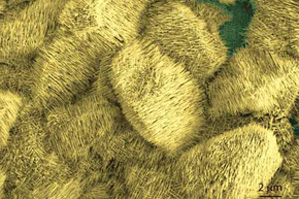Nanowire Hay Bales

 This week at the annual meeting of the American Physical Society, a group of Northeastern scientists will present the Monet painting of the future. This pile of hay bales is not a close up of a lost classic from the impressionist master’s late-nineteenth century haystack series. Instead, it’s a close-up of magnetic nanowires. Pegah M. Hosseinpour, a third year PhD student in the department of chemical engineering, added iron to standard titanium nanotubes giving them magnetic, semi-conducting, and catalytic properties.
This week at the annual meeting of the American Physical Society, a group of Northeastern scientists will present the Monet painting of the future. This pile of hay bales is not a close up of a lost classic from the impressionist master’s late-nineteenth century haystack series. Instead, it’s a close-up of magnetic nanowires. Pegah M. Hosseinpour, a third year PhD student in the department of chemical engineering, added iron to standard titanium nanotubes giving them magnetic, semi-conducting, and catalytic properties.
“Properly engineered, these materials hold promise for potential application in devices to efficiently absorb and transfer solar energy or to process data with increased speed, precision and accuracy,” says Hosseinpour.
This image is featured in the APS image gallery, along with another nanotube masterpiece from the team: A nano-scale “Devil’s postpile.” (A  beautiful geological formation in California made up of columnar basalt, which forms when a lava flow shrinks in the horizontal direction as it rapidly cools.)
beautiful geological formation in California made up of columnar basalt, which forms when a lava flow shrinks in the horizontal direction as it rapidly cools.)
These ——————> are also iron-doped titanium nanowires, but here the scale is even smaller (about 2 orders of magnitude smaller than the hay bales above).
I love that the folks over at APS recognize how lovely a pretty picture can be, even more so with a beautiful scientific story lurking behind it. This makes me wonder about the scientific story behind Monet’s haystacks…there must be one, right?
Nano-photos by Pegah M. Hosseinpour; Postpile photo: Mike Baird, “Devils Postpile National Monument U.S. National Park Service” October 16, 2011 via Flickr, Creative Commons Attribution.





